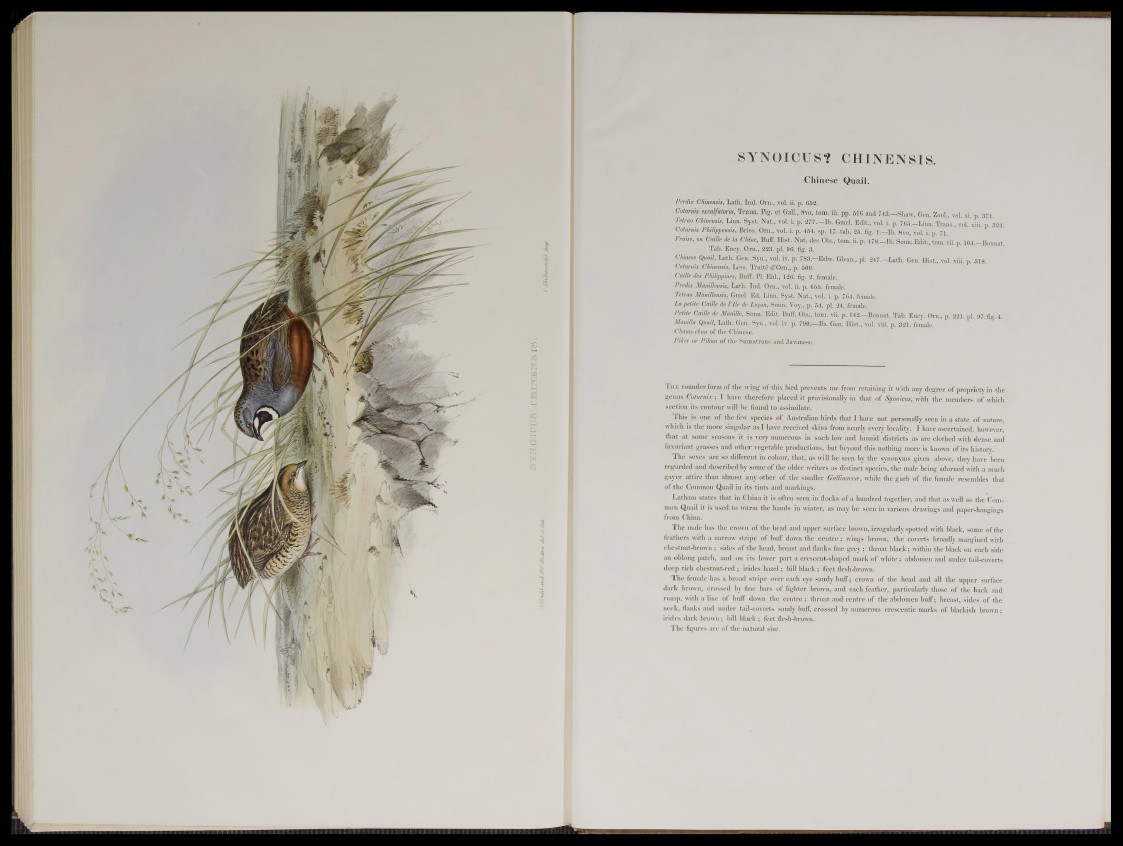
g ï i l l l i^ l l l g ) ; a tii'ml et yAg
s W ^ pH U S ? ÇH1NENSIS.
Chinese Quail.
PerdiD Chinensis, Laf^luHsSr5v§™ u p 'u
Cotejiiç excalfatona ; _U h . ÿj„i Tol 371
3’efrao CAin ™" J J-jT v . v u lJ 'p 'W . Æ * Tim- vol xffi. p. 324.
Potunm PlahppnuK . i p t _ p^l7 u b 1 . jp. ” ',:
Fraise, ou Cai <• la ( hi, I) fj*U t%N t 1 J f ttim f v u p.104,—Boimafc
l l " ' - <i, a 2 17 ■ ^ L a t h . 'G e i 'i ^ ^ î o i : viiî. p .
Goiurnùe Chinensis, .Less, Traité
W H dçs PMlippines,3^-.Pt^nl., |I ^ , I 0 ; % female.
Perdix Manillensis, La&.
Tetrao Manillensis, Gmel volf i? jp. 7G% female.
LapètitéjGaille de,l’île de Lucon. ■ 24. female.
ffçtite Caille i k V f e . 4.
jsfmük Quail, K a B S jS ^ T Æ ^ '.'S a ^ J '^ f ^ î ^ L iwi!- \im V lH K rp a îr ^ ir tiu b -»
Gham-cbm of
Pikan ofthè Sumatrans a n d f f p ^ ^ p \ ï
' Ihi roundtrt jrm ii lit. priiint« mi ir wub inv d ig ru o lp iupruiym the
genus Cotunrn j I fi||<Utherefore placed it provi«ona]lyjj& th a tM ^ |a p fc i» „ :#i{h ^tfie^jmembers of which
conto^uir. will be found to assimilate.
^ on-^ o f c ;f u 3 f e 'S ^ i^ # o f Australian h ttd^tpjfT h a r l o t , personally seen iij,a state of nature,
whinlpiy th j% jo ic \mu u n r sH iu T j i f iu ii i l -.KuiMior^neirK i vcKh. *111 v' ' I *& £?'X u rtw n d, bowiwr,
3 8 f | l ' » " I f i B a » ind humid districts as are clothed with dense and
luxuriant grasses and othei vegetable piudv(tion.,tOu^,br\onHthie notlung mon iy*Jjio»nof its liu-lorv
‘ The sexes are so different jKJggJouir that, ^gmjlftjc seen by the synonyms given diigejfiheChisf been
regarded and described by some of th^oldi r v v ^ ^ ^ B 5di~imf.t sp’ri ir., the male being adorned with a much
ijNfer attire than almost .any other of tf ie ^ a p% GaUimcece, whileit 1ft'garb of t i e female resembles that
of the Common Quail in l^ tin ts . and markings.
Latham states that i p f ^ in a i t i s often seenin, flocksof a |u n |y e d together, and that as well as^the®#»!
U?od Quail it is used to #&rm the hands in winter, as various drawingsand paper-hangings
from China.
The male has the c row n ^ th e head and u p |^ fsu rf a e e /h |o ^ ^ p fg S a rly s p o tte # ^ S ^ a c k , some of the
feathers with a narrow stripe of buff down the centre ; vwings the coverts broadly margined with
chestnut-brown ; sides of the head, breast and flanks fine grey ; ‘throat'bjaek 5 within the Black on each side
an oblong pafch, and on its lower part a crescent-shaped mark of white; abdomen and\under tail-coverts
deeprichchesthut-red; irides hazel; bin_blaekjr feet flesh-brown.
The female has a broad stripe over each eye sandy buffi1;, ^ ^ n ^ f l j h e head and all the upper suifade^
dark brown, crossed by fine bars of lighter brown, and eacEfeather, particularly those oft the back and
rump, with a line b f huff down the centre; throat and c e n t^ o f the abdomen, Bpffi;, breast, sides of the
neck, flanks and under tail-coverts sanity buff, crossed by numerous crescentic marks of blackish brown ; .
irides dark brewn’i bill black ;* feet flesh-brown.
’ ^ lte figures are of the natural size.